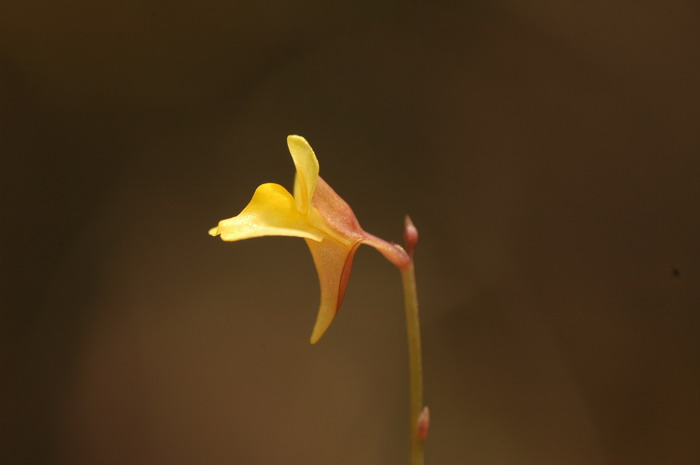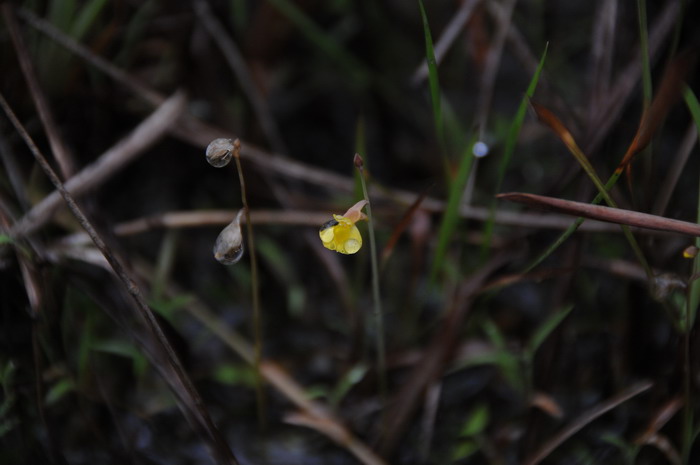挖耳草Utricularia bifida
中文名(Chinese Name):挖耳草
学名(Scientific Name):Utricularia bifida L.
英文名(English Common Name):bladderwort
别名(Chinese Common Name):金耳挖,割鸡芒
异名(Synonym):Nelipus bifida (L.) Raf. Utricularia alata Benj. Utricularia antirrhinoides Wall. Utricularia brevicaulis Benj. Utricularia recurva Lour. Utricularia sumatrana Miq.
科属(Family & Genus):狸藻科(Lentibulariaceae)狸藻属
形态特征(Description):陆生小草本。假根少数,丝状,基部增厚,具多数长0.5-1毫米的乳头状分枝。匍匐枝少数,丝状,具分枝。叶器生于匍匐枝上,于开花前凋萎或于花期宿存,狭线形或线状倒披针形,顶端急尖或钝形,长7-30毫米,宽1-4毫米,膜质,无毛,具1脉。捕虫囊生于叶器及匍匐枝上,球形,侧扁,长0.6-1毫米,具柄;口基生,上唇具2条钻形附属物,下唇钝形,无附属物。花序直立,长2-40厘米,中部以上具1-16朵疏离的花;花序梗圆柱状,粗0.3-1毫米,上部光滑,下部具细小的腺体,具1-5鳞片;苞片与鳞片相似,基部着生,宽卵状长圆形,顶端钝,长约1毫米;小苞片线状披针形,长约0.5毫米;花梗长2-5毫米,丝状,具翅,于花期直立,花后伸长并下弯。花萼2裂达基部,上唇稍大,裂片宽卵形,顶端钝,基部下延,花期长3-4毫米,果期增大,长5-6毫米,无毛。花冠黄色,长6-10毫米,外面无毛;上唇狭长圆形或长卵形,顶端圆形,长3-4.5毫米,宽2-3毫米,下唇近圆形,长4-4.5毫米,宽3.5-4毫米,顶端圆形或具2-3浅圆齿,喉凸隆起呈浅囊状;距钻形,长3-5毫米,与下唇成锐角或钝角叉开。雄蕊无毛;花丝线形,长约1毫米,近伸直,上部略膨大;药室于顶端汇合。雌蕊无毛;子房卵球形;花柱短而显著;柱头下唇近圆形,反曲,上唇较短,钝形。蒴果宽椭圆球形,背腹扁,果皮膜质,长2.5-3毫米,室背开裂。种子多数,卵球形或长球形,长0.4-0.6毫米;种皮无毛,具网状突起,网格纵向延长,多少扭曲。花期6-12月,果期7月一次年1月。
分布(Distribution):产山东、江苏、安徽、浙江、江西、福建、台湾、河南、湖北、湖南、广东、海南、广西、四川和云南。生于沼泽地、稻田或沟边湿地,海拔40-1350米。也分布于印度、孟加拉、中南半岛、马来西亚、菲律宾、印度尼西亚、日本和澳大利亚北部。
用途(Use):引自植物志英文版:FOC Vol. 19 Page 482, 484
FOC | Family List | FOC Vol. 19
5. Utricularia bifida Linnaeus, Sp. Pl. 1: 18. 1753.
挖耳草 wa er cao| Lentibulariaceae | Utricularia
Philydrum cavaleriei H. Léveillé; Utricularia alata Benjamin; U. biflora Hayata (1911), not Lamarck (1791); U. humilis Vahl; U. recurva Loureiro; U. wallichiana Benjamin.
Annuals, terrestrial. Rhizoids and stolons capillary, branched. Traps on stolons and leaves, shortly stalked, globose, 0.5-1 mm, mouth basal; appendages 2, dorsal, subulate, curved. Leaves arising from stolon nodes, few to numerous, petiolate; leaf blade narrowly linear to linear-oblanceolate, 0.7-2(-3) cm × 1-4 mm, membranous, glabrous, vein 1, base attenuate, margin entire, apex rounded to subacute. Inflorescences erect, 2-40 cm, 1-16-flowered, glabrous; peduncle terete, 0.3-1.2 mm thick; scales few, similar to bracts; bracts basifixed, ovate, 1-2 mm, apex obtuse to acute. Pedicel spreading at anthesis but decurved in fruit, 2-5 mm, capillary, broadly winged; bracteoles subulate, much shorter than bracts, apex acute. Calyx lobes 3-4 mm at anthesis but 5-6 mm in fruit, glabrous; lower lobe ovate, slightly smaller than upper lobes, apex rounded to emarginate; upper lobe broadly ovate, apex obtuse. Corolla yellow, 6-10 mm; lower lip suborbicular, base with a prominent rounded swelling, apex rounded; spur subulate, ± as long as lower corolla lip, widely divergent, curved, apex acute; palate margin ciliate; upper lip oblong to oblong-obovate, apex rounded. Filaments ca. 1 mm, straight; anther thecae distinct. Ovary ovoid, dorsiventrally compressed; style evident; stigma lower lip semicircular, upper lip obtuse. Capsule broadly ellipsoid, 2.5-3 mm, dorsiventrally compressed, dehiscing by longitudinal dorsal and ventral slits. Seeds obliquely obovoid, 0.4-0.6 mm; seed coat with prominent elongate reticulations. Fl. Jun-Dec, fr. Jul-Jan.
Wet soil and rocks, rice fields; near sea level to 1400 m. Anhui, Chongqing, Fujian, Guangdong, Guangxi, Guizhou, Hainan, Henan, Hubei, Hunan, Jiangsu, Jiangxi, Shandong, Taiwan, Yunnan, Zhejiang [Bangladesh, Cambodia, India, Indonesia, Japan, Korea, Laos, Malaysia, Myanmar, Nepal, Papua New Guinea, Philippines, Sri Lanka, Thailand, Vietnam; N Australia, Pacific islands (Guam, Palau)].


(责任编辑:徐晔春)
学名(Scientific Name):Utricularia bifida L.
英文名(English Common Name):bladderwort
别名(Chinese Common Name):金耳挖,割鸡芒
异名(Synonym):Nelipus bifida (L.) Raf. Utricularia alata Benj. Utricularia antirrhinoides Wall. Utricularia brevicaulis Benj. Utricularia recurva Lour. Utricularia sumatrana Miq.
科属(Family & Genus):狸藻科(Lentibulariaceae)狸藻属
形态特征(Description):陆生小草本。假根少数,丝状,基部增厚,具多数长0.5-1毫米的乳头状分枝。匍匐枝少数,丝状,具分枝。叶器生于匍匐枝上,于开花前凋萎或于花期宿存,狭线形或线状倒披针形,顶端急尖或钝形,长7-30毫米,宽1-4毫米,膜质,无毛,具1脉。捕虫囊生于叶器及匍匐枝上,球形,侧扁,长0.6-1毫米,具柄;口基生,上唇具2条钻形附属物,下唇钝形,无附属物。花序直立,长2-40厘米,中部以上具1-16朵疏离的花;花序梗圆柱状,粗0.3-1毫米,上部光滑,下部具细小的腺体,具1-5鳞片;苞片与鳞片相似,基部着生,宽卵状长圆形,顶端钝,长约1毫米;小苞片线状披针形,长约0.5毫米;花梗长2-5毫米,丝状,具翅,于花期直立,花后伸长并下弯。花萼2裂达基部,上唇稍大,裂片宽卵形,顶端钝,基部下延,花期长3-4毫米,果期增大,长5-6毫米,无毛。花冠黄色,长6-10毫米,外面无毛;上唇狭长圆形或长卵形,顶端圆形,长3-4.5毫米,宽2-3毫米,下唇近圆形,长4-4.5毫米,宽3.5-4毫米,顶端圆形或具2-3浅圆齿,喉凸隆起呈浅囊状;距钻形,长3-5毫米,与下唇成锐角或钝角叉开。雄蕊无毛;花丝线形,长约1毫米,近伸直,上部略膨大;药室于顶端汇合。雌蕊无毛;子房卵球形;花柱短而显著;柱头下唇近圆形,反曲,上唇较短,钝形。蒴果宽椭圆球形,背腹扁,果皮膜质,长2.5-3毫米,室背开裂。种子多数,卵球形或长球形,长0.4-0.6毫米;种皮无毛,具网状突起,网格纵向延长,多少扭曲。花期6-12月,果期7月一次年1月。
分布(Distribution):产山东、江苏、安徽、浙江、江西、福建、台湾、河南、湖北、湖南、广东、海南、广西、四川和云南。生于沼泽地、稻田或沟边湿地,海拔40-1350米。也分布于印度、孟加拉、中南半岛、马来西亚、菲律宾、印度尼西亚、日本和澳大利亚北部。
用途(Use):引自植物志英文版:FOC Vol. 19 Page 482, 484
FOC | Family List | FOC Vol. 19
5. Utricularia bifida Linnaeus, Sp. Pl. 1: 18. 1753.
挖耳草 wa er cao| Lentibulariaceae | Utricularia
Philydrum cavaleriei H. Léveillé; Utricularia alata Benjamin; U. biflora Hayata (1911), not Lamarck (1791); U. humilis Vahl; U. recurva Loureiro; U. wallichiana Benjamin.
Annuals, terrestrial. Rhizoids and stolons capillary, branched. Traps on stolons and leaves, shortly stalked, globose, 0.5-1 mm, mouth basal; appendages 2, dorsal, subulate, curved. Leaves arising from stolon nodes, few to numerous, petiolate; leaf blade narrowly linear to linear-oblanceolate, 0.7-2(-3) cm × 1-4 mm, membranous, glabrous, vein 1, base attenuate, margin entire, apex rounded to subacute. Inflorescences erect, 2-40 cm, 1-16-flowered, glabrous; peduncle terete, 0.3-1.2 mm thick; scales few, similar to bracts; bracts basifixed, ovate, 1-2 mm, apex obtuse to acute. Pedicel spreading at anthesis but decurved in fruit, 2-5 mm, capillary, broadly winged; bracteoles subulate, much shorter than bracts, apex acute. Calyx lobes 3-4 mm at anthesis but 5-6 mm in fruit, glabrous; lower lobe ovate, slightly smaller than upper lobes, apex rounded to emarginate; upper lobe broadly ovate, apex obtuse. Corolla yellow, 6-10 mm; lower lip suborbicular, base with a prominent rounded swelling, apex rounded; spur subulate, ± as long as lower corolla lip, widely divergent, curved, apex acute; palate margin ciliate; upper lip oblong to oblong-obovate, apex rounded. Filaments ca. 1 mm, straight; anther thecae distinct. Ovary ovoid, dorsiventrally compressed; style evident; stigma lower lip semicircular, upper lip obtuse. Capsule broadly ellipsoid, 2.5-3 mm, dorsiventrally compressed, dehiscing by longitudinal dorsal and ventral slits. Seeds obliquely obovoid, 0.4-0.6 mm; seed coat with prominent elongate reticulations. Fl. Jun-Dec, fr. Jul-Jan.
Wet soil and rocks, rice fields; near sea level to 1400 m. Anhui, Chongqing, Fujian, Guangdong, Guangxi, Guizhou, Hainan, Henan, Hubei, Hunan, Jiangsu, Jiangxi, Shandong, Taiwan, Yunnan, Zhejiang [Bangladesh, Cambodia, India, Indonesia, Japan, Korea, Laos, Malaysia, Myanmar, Nepal, Papua New Guinea, Philippines, Sri Lanka, Thailand, Vietnam; N Australia, Pacific islands (Guam, Palau)].
(责任编辑:徐晔春)
踩一下[0]

顶一下[1]